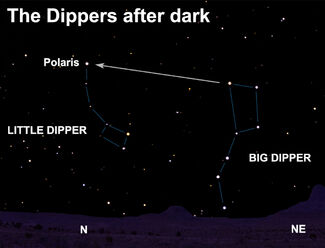The Return of the Big Dipper
Last updated 2/19/2021 at 9:47am

The Little Dipper's stars are so dim that you may have a tough time seeing most of them from near the bright lights of a city.
Scientists tell us that our sense of smell is one of the most powerful memory triggers. Get a whiff of a freshly mown lawn or a turkey roasting in the oven and I'll bet you agree.
For me, there's another memory trigger that seems to work equally well: spotting the Big Dipper in the nighttime sky of February.
I remember back to my childhood in Pennsylvania, when springtime was a welcome relief after the brutal winter months just past. One of my favorite daytime activities of February was to brush away the deep snow in my mom's garden to look for signs that life was returning to our part of planet Earth. And, oh, what excitement I felt when I saw those first tiny green buds poking out of the frozen soil!
"Yes!" I thought. "Spring is coming!"
I also recall waiting each night until dark to stand in my backyard in search of the Big Dipper. It was never visible during the early evening hours of wintertime, but with springtime on its way, I knew that this famous star grouping would soon reappear over my rooftop.
And sure enough, it always did!
Many decades have passed since that halcyon time in my life, but I still look forward to February every year so I can become reacquainted with some of my earliest celestial friends. My first late-winter sighting of the Big Dipper fills my mind and heart with memories of those wonderful days and nights, and it still reminds me that springtime is just around the corner.
You, too, can find the Big Dipper at this time of year quite easily. Look low toward the northeastern sky after dark, and unless you've got terrain or buildings in your way, you'll see it standing on its handle. You can also use the Big Dipper's two "pointer stars" – those farthest from its handle – to point the way toward Polaris, the North Star.
Find Polaris and you're not only facing true north, but you might also be able to spot the Little Dipper. But before you begin your search, there are three things you might like to remember about the Little Dipper. First, Polaris marks the end of its handle. Second, the Little Dipper is smaller than the Big Dipper and is inverted. And third, it's faint.
Very faint.
In fact, the Little Dipper's stars are so dim that you may have a tough time seeing most of them from near the bright lights of a city. From these light-polluted areas, you might be lucky even to find Polaris and the two relatively bright "guardian" stars (those farthest from its handle). We call them the guardians because they circle Polaris during the night as if protecting this important celestial marker.
Your best bet is to drive to a darker site in the wilderness, where your view to the north is open, and you'll have a much easier time locating all seven stars of the Little Dipper.
Finding the Big Dipper in the evening sky may not make the long, cold winter disappear, but I promise it will offer celestial hope that springtime is not far away!
Visit Dennis Mammana at dennismammana.com.



